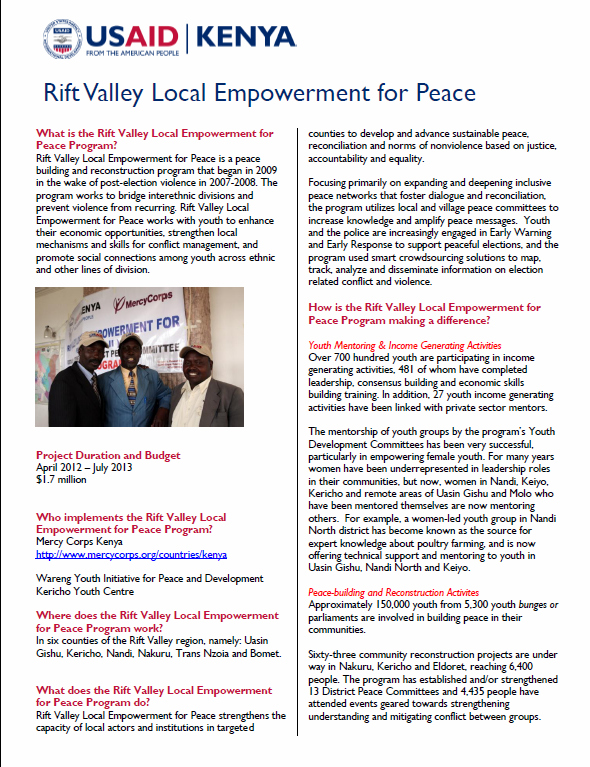What is the Rift Valley Local Empowerment for Peace Program?
Rift Valley Local Empowerment for Peace is a peace building and reconstruction program that began in 2009 in the wake of post-election violence in 2007-2008. The program works to bridge interethnic divisions and prevent violence from recurring. Rift Valley Local Empowerment for Peace works with youth to enhance their economic opportunities, strengthen local mechanisms and skills for conflict management, and promote social connections among youth across ethnic and other lines of division.
Project Duration and Budget
April 2012 – July 2013
$1.7 million
Who implements the Rift Valley Local Empowerment for Peace Program?
Mercy Corps Kenya
http://www.mercycorps.org/countries/kenya
Wareng Youth Initiative for Peace and Development
Kericho Youth Centre
Where does the Rift Valley Local Empowerment for Peace Program work?
In six counties of the Rift Valley region, namely: Uasin Gishu, Kericho, Nandi, Nakuru, Trans Nzoia and Bomet.
What does the Rift Valley Local Empowerment for Peace Program do?
Rift Valley Local Empowerment for Peace strengthens the capacity of local actors and institutions in targeted counties to develop and advance sustainable peace, reconciliation and norms of nonviolence based on justice, accountability and equality.
Focusing primarily on expanding and deepening inclusive peace networks that foster dialogue and reconciliation, the program utilizes local and village peace committees to increase knowledge and amplify peace messages. Youth and the police are increasingly engaged in Early Warning and Early Response to support peaceful elections, and the program used smart crowdsourcing solutions to map, track, analyze and disseminate information on election related conflict and violence.
How is the Rift Valley Local Empowerment for Peace Program making a difference?
Youth Mentoring & Income Generating Activities
Over 700 hundred youth are participating in income generating activities, 481 of whom have completed leadership, consensus building and economic skills building training. In addition, 27 youth income generating activities have been linked with private sector mentors.
The mentorship of youth groups by the program’s Youth Development Committees has been very successful, particularly in empowering female youth. For many years women have been underrepresented in leadership roles in their communities, but now, women in Nandi, Keiyo, Kericho and remote areas of Uasin Gishu and Molo who have been mentored themselves are now mentoring others. For example, a women-led youth group in Nandi North district has become known as the source for expert knowledge about poultry farming, and is now offering technical support and mentoring to youth in Uasin Gishu, Nandi North and Keiyo.
Peace-building and Reconstruction Activites
Approximately 150,000 youth from 5,300 youth bunges or parliaments are involved in building peace in their communities.
Sixty-three community reconstruction projects are under way in Nakuru, Kericho and Eldoret, reaching 6,400 people. The program has established and/or strengthened 13 District Peace Committees and 4,435 people have attended events geared towards strengthening understanding and mitigating conflict between groups.
In May 2012, the District Peace Committee of Nandi North was able to intervene in clashes that broke out in Muhoroni-Chemelil along the border of Rift Valley and Nyanza provinces. The Committee mobilized support of the Nandi Council of Elders to lead negotiations for peace with the Luo Council of Elders. This effort was complemented by the efforts of the Wareng Youth Initiative for Peace who mobilized youth bunges (youth parliaments) along the border for dialogue. The result of these efforts was a halt in the conflict and the development of sustainable strategies for peace now being implemented in the run up to elections.
During the 2013 general elections, the program trained 582 peace monitors who were located in strategic potential hot spot locations in six counties of the Rift Valley. Over 350 of these peace monitors reported into two joint humanitarian early warning /early response hubs in Eldoret and Nakuru. The hubs used an innovative crowd-mapping platform to monitor the elections and their co-location allowed for greater information sharing between the humanitarian and conflict prevention actors.
What key challenges does the Rift Valley Local Empowerment for Peace Program face?
Rift Valley, Kenya’s most populous and ethnically diverse province was the epicenter of Kenya’s 2007-2008 post-election violence. Ethnic violence in the Rift Valley – although often at its extremes during election periods – is as an ‘everyday phenomenon.’ Disagreements about anything tend to take an ethnic and often political dimension and with it verbal and physical violence against the perceived ‘enemy’ tribe.
In the lead-up to the 2013 national elections, an increasingly charged political environment put pressure on partner community organizations. However, timely action by the District Peace Committees and the coordinated efforts of local and village-based peace actors prevented a reoccurrence of post-election violence.
Individuals and organizations with drive, charisma and talent to foster positive change have been identified as “bright spots” and are mentoring newly formed peace committees to guarantee a secure and peaceful Kenya in the future.
For more information:
http://www.mercycorps.org/countries/kenya
John Smith-Sreen, Director
Office of Democracy, Rights and Governance, USAID/Kenya
Tel: +254 20 862 2000
E-mail: jsmith-sreen@usaid.gov
Monica Azimi, Deputy Director
Office of Democracy, Rights and Governance
USAID/Kenya
Tel: +254 (0) 724 256 758
Email: mmcqueary@usaid.gov
Richard Omari Onyancha, Chief of Party
Mercy Corps, Kenya
Tel: + 254 (0) 725 818 975
Email: ronyancha@ke.mercycorps.org
Updated April 2013








Comment
Make a general inquiry or suggest an improvement.